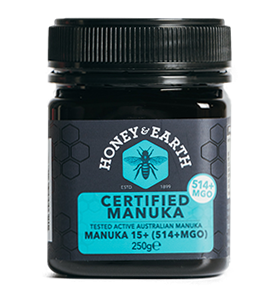Description
The sweet facts
Our Manuka honey 5+ comes from the Australian Manuka and Jellybush plants which grow along the pristine and beautiful NSW coastline of Australia. The delicate white flowers from these plants produce a nectar that the bees convert to manuka honey 5+.
The scientific facts
We send every batch of manuka honey 5+ we collect to an independent laboratory at The University of the Sunshine Coast’s Honey Lab so every strength is top-quality!
Why is Manuka so valuable?
Because it’s Mother Nature’s medicine made by bees for humans.
It has many amazing qualities including:
It helps fights germs and has nutritional qualities
it’s used for its antibacterial properties because it stimulates the immune system, reduces inflammation and draws out pus from wounds
makes it difficult for bacteria to survive because it adds natural hydrogen peroxide and draws out moisture
good for skin conditions, sore throats, gingivitis, mouth ulcers, sore gums, gastric upsets like indigestion
has prebiotics which help support gut health
bacteria or superbugs that resist antibiotics aren’t resistant to manuka!
FAQ about manuka honey
Q1. What’s the difference between manuka honey produced in Australia and New Zealand?
We love our Kiwi neighbours but the truth is Aussie manuka honey is considered superior to NZ manuka honey because of the following:
New Zealand beekeepers often use a chemical called a miticide to kill a pest called varroa mite. This pest is not found in Australia so Australian manuka honey is free from miticide.
Research has also found that Australian manuka honey is the most powerfully active manuka honey in the world. And Australia has over 90 species of the leptospermum plant which provides the nectar to the bees.
Q2. How do I know which manuka honey companies to trust?
Good companies will always carry the Australian Manuka Honey Association (AMHA) mark of authenticity.
All active Australian Manuka honey that carries this mark must be pure natural honey, produced entirely in Australia, and must be tested by an independent approved laboratory.
All our manuka honey is tested independently and certified for different strengths in a lab.
The lab also tests for MGO, DHA levels and leptosperin, a naturally occurring chemical found only in the nectar or manuka plants to ensure that it meets the minimum following criteria when packed:
1. > 85mg/kg (or ppm) methylglyoxal (MGO)
2. > 170mg/kg (or ppm) dihydroxyacetone (DHA)
3. > 50g/kg (or ppm) leptosperin
Q3. What do all the different strengths of manuka mean?
Different manuka honey strengths mean that the higher the rating, the higher its medicinal quality and properties.
Q4. What’s the difference between NPA®, UMF and MGO?
· MGO is the shortened version of the word methylglyoxal. Methylglyoxal is the “secret sauce” of Manuka, it’s the naturally occurring antibacterial compound that makes Manuka honey special.
· UMF® is the registered trademark of the UMF® Honey Association of New Zealand while NPA (non-peroxide activity) is used in Australia to describe the unique antimicrobial activity of manuka honey.
· UMF® and NPA (non-peroxide activity) are the equivalent of each other when tested by an appropriate laboratory where special equipment measures the levels of MGO
Q5. What does manuka honey taste like?
Manuka is a strong-smelling, grainy, thick and creamy honey and its strong personality can put some people off from eating it. Our expert tip is to use it for medicinal purposes only and choose a lighter honey for eating.
NB: Due to quarantine laws, our honey and beeswax is not able to be sent from NSW to WA or Kangaroo Island. Please do not order for delivery to these regions.









Reviews
There are no reviews yet.